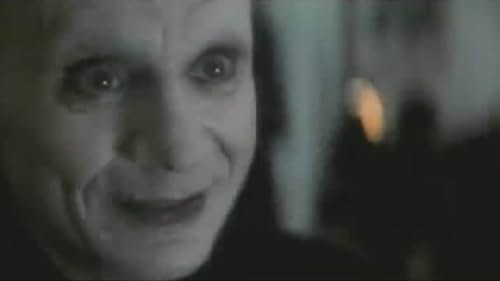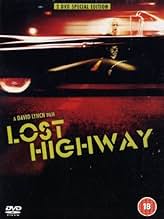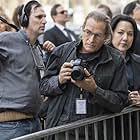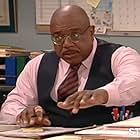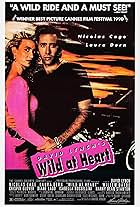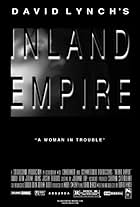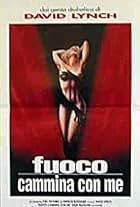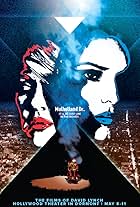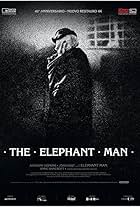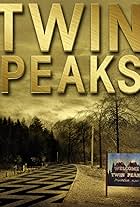All'indomani di un bizzarro incontro durante una festa, un sassofonista jazz viene accusato dell'omicidio della moglie e viene mandato in prigione, nella quale si tramuta inspiegabilmente in... Leggi tuttoAll'indomani di un bizzarro incontro durante una festa, un sassofonista jazz viene accusato dell'omicidio della moglie e viene mandato in prigione, nella quale si tramuta inspiegabilmente in un giovane meccanico e comincia a condurre una nuova vita.All'indomani di un bizzarro incontro durante una festa, un sassofonista jazz viene accusato dell'omicidio della moglie e viene mandato in prigione, nella quale si tramuta inspiegabilmente in un giovane meccanico e comincia a condurre una nuova vita.
- Premi
- 4 vittorie e 6 candidature
Trama
Lo sapevi?
- QuizAccording to co-writer and director David Lynch, the first scene in the film is based on an incident that occurred in his own life. He claims his intercom buzzed early one morning and when he answered it, a voice on the other end that he didn't recognize said, "Dick Laurant is dead." However, by the time he got to the front of the house to look out the window, there was no one outside.
- BlooperWhen Pete and Sheila are having sex in the car, external shots show the car parked alongside a wall in a dark, tree-covered section of street. Yet in interior shots, the wall is many metres away in the far background and is brightly illuminated.
- Citazioni
Ed: Do you own a video camera?
Renee Madison: No. Fred hates them.
Fred Madison: I like to remember things my own way.
Ed: What do you mean by that?
Fred Madison: How I remembered them. Not necessarily the way they happened.
- Curiosità sui creditiA Real Trooper-Guadalupe Hurst
- Versioni alternativeAn unconfirmed report claims that a Director's Cut of the film exists which has a number of scenes deleted from the original 134 minute print. Some of the missing scenes include:
- A breakfast scene with Fred and Renee where Fred asks her where she was when he phoned her from the jazz club the night before, and when she says that she never left the house all evening, his suspicions of her cheating on him intensifies.
- Another scene of a third videotape arriving at Fred and Renee's house where they watch it and catch a glimpse of a cold-faced Fred on one frame. They phone the detectives Al and Lou again who pay them another visit.
- A scene set in the morgue where the attendant, George, prepares an autopsy on Renee's mutilated body where he is joined by a tuxedo-clad medical examiner and the examiner's girlfriend, Joyce, which is immediately followed by a courtroom scene where Fred literally faints after hearing the jury forewoman read the guilty verdict and the judge's sentence of death, which is only heard in the original version.
- A scene in a lingerie shop where two young women, Marian and Raquel, glimpsed only in the porno film at the end, talk about the Renee Madison murder and about the method of execution the state would use when they are interrupted by Andy who gestures for them to hurry up with their selections.
- Another scene follows where Andy, Marian and Raquel are involved in a drugged-out threesome orgy at his house.
- A prison scene where one inmate is shown being led out of his cell to the gas chamber with other prisoners taunting him and the guards preparing for the execution as if it was a formal gathering, plus another scene of Fred talking to the prison guards in the courtyard the next day.
- A full scene of dialogue between the prison warden and Pete Dayton's parents, Candace and Bill, where they are told of their son's whereabouts and his physical condition where he has a hematoma on his forehead and blepharitis, redness around the eyes. Bill and Candace are elusive to the warden's questions about Pete's whereabouts for the last few days. Pete is then brought into the office where he doesn't respond to questions asked, and Bill and Candace are told that they can take him home. After they leave, the warden then makes a statement to reporters outside his office about the disappearance of Fred Madison from the prison.
- Extended scenes of dialogue between Pete and his friends Steve V, Teddy, Carl and Lanie on their arrival at his house where Lanie shows them a scar on her abdomen from an operation she just had. Plus more dialogue as the four of them ride in Steve V's car, where they first arrive at a drive-in restaurant called Johnny's where they pick up Sheila and her two girlfriends and then drive to the bowling alley.
- An extra scene of Pete riding up Van Nuys Boulevard at night on his motorcycle after Alice had phoned him to cancel their evening get-together. Pete arrives at Johnny's Drive-In where he meets with Steve V, Carl and Sheila where Pete responds awkward towards them as he is having a mysterious headache. Pete then savagely beats up two guys who try to pick up Sheila, much to her shock.
- The telephone scene between Pete, Mr. Eddy and the Mystery Man is slightly extended with more dialogue with the Mystery Man telling Pete about him just killing some people and telling him more details about executions in the 'Far East' set to imply China during the Cultural Revolution.
- A brief scene of Fred Madison checking into the Lost Highway Motel and walking towards Room 25 which he knows is right next to Room 26 where Renee and Mr. Eddy are.
- Colonne sonoreI'm Deranged
Written by David Bowie and Brian Eno
Courtesy of Tintoretto Music (BMI) and Upala Music (BMI)
Performed by David Bowie
Courtesy of Jones Music and Virgin Records America, Inc.
I'm not sure if there is much content or ideas in Lost Highway that aren't explored in a more satisfying way in other Lynch content. I think calling it a test run or precursor for Mulholland Drive (as I've heard) is apt. It almost feels like a shadow reflection or imitation of his other works.
To watch the film as it is presented, on a surface level, would leave most viewers completely unmoored, frustrated and confused. There's an icy, aloof detachment and distance to the film (including some very subdued performances) that almost pushes a viewer away in an unwelcoming manner. As if to say, you're just not smart enough to understand this, with a patronising pat on the back - like the important one given to Fred within the film. I can understand why many viewers would bristle at this kind of artsy condescension. It's definitely not a film that wants to hold a viewers hand, quite the opposite.
I think this film is a moody and disconcerting experience, but not the most enjoyable of Lynch content to consume. I definitely wouldn't call it a fun watch. If I was to revisit the films of Lynch I don't think this would be a priority, but I appreciate it for what it is.
I don't know if the long runtime is justified. It makes watching it even more of an investment. I'd be curious to see if the same ideas could be conveyed in a more condensed fashion.
I do enjoy watching Bill Pullman and Balthazar Getty in the film. Their performances are pretty spot on I think. But performances become pretty irrelevant when the whole idea of plot or narrative breaks down. It just comes untethered.
It pretty much goes without saying that there is some spectacular imagery too. It is Lynch after all.
I had a really bad headache while watching, which made my viewing even more uncomfortable. The fact that wife killer Fred was simultaneously experiencing one was a bit trippy.
- injury-65447
- 28 gen 2021
- Permalink
I più visti
Dettagli
- Data di uscita
- Paesi di origine
- Sito ufficiale
- Lingua
- Celebre anche come
- Por el lado oscuro del camino
- Luoghi delle riprese
- 7035 Senalda Road, Los Angeles, California, Stati Uniti(Fred Madison's house)
- Aziende produttrici
- Vedi altri crediti dell’azienda su IMDbPro
Botteghino
- Budget
- 15.000.000 USD (previsto)
- Lordo Stati Uniti e Canada
- 3.726.792 USD
- Fine settimana di apertura Stati Uniti e Canada
- 212.710 USD
- 23 feb 1997
- Lordo in tutto il mondo
- 3.836.866 USD
- Tempo di esecuzione2 ore 14 minuti
- Colore
- Mix di suoni
- Proporzioni
- 2.39 : 1
Contribuisci a questa pagina


